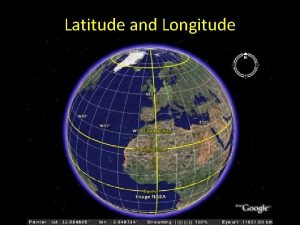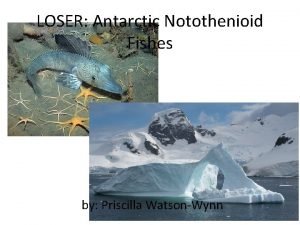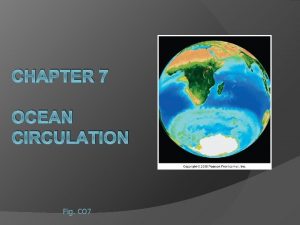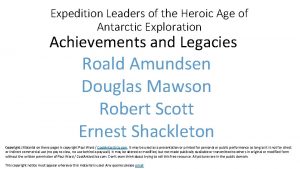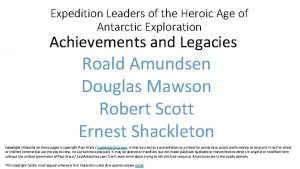Expedition Leaders of the Heroic Age of Antarctic










- Slides: 10

Expedition Leaders of the Heroic Age of Antarctic Exploration Achievements and Legacies Who was Roald Amundsen? Copyright: This resource is provided free by Cool. Antarctica. com, you’re welcome. It cannot be distributed by any other means, believe it or not people sometimes lift free resources and distribute them pretending they have been allowed to or even sell them as their own – I know! It’s shocking! If anyone asks you for payment for this or if you get it but not from Cool. Antarctica. com, please email danthwhaler@gmail. com and the ghost of whaler Dan will exact retribution on the scurvy dogs. This copyright notice must appear wherever this material is used. Any queries please email

Roald Amundsen 1872 1928 Norwegian Roald Amundsen led the first successful expedition to reach the South Pole, he arrived there on the 14 th of December 1911. A team of 5 men arrived there by dog sled 57 days after leaving their winter base camp and their ship the Fram. They had all gained weight on the journey to the pole. After a short break, the journey back to their ship took them 39 days. Amundsen and his party at the Pole They had set out with 52 dogs and returned with 11, the rest had been killed to feed the others and the men along the way. The returning dogs and men were all in good health.

Amundsen was 39 years old at the time, he was an expert in polar travel having spent his whole adult life involved in extreme travel and exploration in the Arctic. Wild places and exploration were what he lived for. Amundsen had lived alongside Inuit peoples in the Arctic, he learned their survival techniques, how to travel with dog sleds and how to dress for extreme cold using furs whether at rest or involved in strenuous activity. Roald Amundsen

The men he took with him were also experienced in polar conditions. His South Pole journey was very focussed, there were virtually no scientific measurements taken and no scientists. The trip was meticulously planned and executed, every detail of food stores and all equipment was tested and evaluated in advance and modified if necessary, nothing was left to chance if it could possibly be addressed. Olav Bjaaland, one of the South Pole party He proved beyond any doubt that planning and skill in using dogs and skis were of extreme importance in a polar environment where “difficulties” could mean the difference between success or death.

Scott’s Terra Nova and Amundsen’s Fram meet in the Bay of Whales Much is made of the “Race to the Pole” with Robert Scott. It was only really Amundsen who decided there was a race. He had intended to be the first to the north pole, but shortly before he was ready, the news broke that two other explorers, Cook and Peary had already reached it.

Having invested more time and money than he could afford to lose, Amundsen had debts to pay and backers depending on him. He decided to try for the South Pole instead, even though he knew Scott had already set off thinking his was the only attempt at that time. Amundsen didn’t even tell his own crew when they set off from Norway aboard the ship Fram, just the captain and two others. The rest were told after the ship had sailed thousands of miles south to the island of Madeira. Amundsen was considered to have acted in an ungentlemanly manner which in 1911 was about as serious an accusation as could be made.

After returning from Antarctica, Amundsen paid off his debts and used the money he made to establish a successful shipping business. He used the money from this to finance exploration of the Arctic by air. He never returned to Antarctica. He died in June 1928, 17 years after reaching the pole with a crew of five in a small flying boat that took off from Tromso, Norway. He was on a rescue mission for the Italian balloonist Nobile and two others whose airship had crashed on the way back from the North Pole

Amundsen and his party at the South Pole, they left a small tent and a message for Scott Amundsen took the criticism of the manner in which he became first to the South Pole badly. It is said that he was much troubled by the fact that Scott and his men died, though his actions had no actual impact or influence on Scott's men prior to their reaching the pole. He was described as unhappy and that he felt the rest of his life to be an anti-climax.

Amundsen didn't receive the same adulation or financial security as his mentor, the Norwegian explorer and national hero Nansen, even though his achievements eclipsed those of Nansen. Amundsen had become the first person to visit both poles when he drifted over the north pole in an airship from Spitsbergen in Norway to Alaska in 1926 and had led the first successful navigation of the fabled North -West Passage in 1903 -1906 in the Gjoa.

Amundsen was overlooked for many years, largely being in the shadow of Scott, it was only when the Scott myth began to be questioned from the late 1960's onwards that Amundsen’s story began to emerge from the shadows somewhat, even in his native Norway. Not until the 100 th anniversary of reaching the pole, on the 14 th of December 2011 was a South Pole monument to Amundsen and his party unveiled in Oslo, the Norwegian capital. There is now a research station at the South Pole called the Amundsen-Scott station and many features in Antarctica named for Amundsen.
 Cool antarctica.com
Cool antarctica.com Antarctic expedition
Antarctic expedition Stone age, bronze age iron age timeline
Stone age, bronze age iron age timeline Iron age bronze age stone age timeline
Iron age bronze age stone age timeline Is the equator a line of latitude
Is the equator a line of latitude Antarctic pearlwort
Antarctic pearlwort Nototheniod
Nototheniod Antarctic toothfish price
Antarctic toothfish price Australian antarctic data centre
Australian antarctic data centre Antarctic circumpolar current
Antarctic circumpolar current Antarctic journal four months at the bottom of the world
Antarctic journal four months at the bottom of the world




